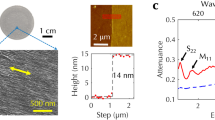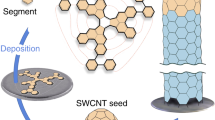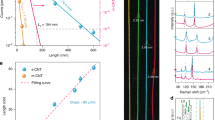Abstract
The semiconductor industry is increasingly of the view that Moore’s law—which predicts the biennial doubling of the number of transistors per microprocessor chip—is nearing its end1. Consequently, the pursuit of alternative semiconducting materials for nanoelectronic devices, including single-walled carbon nanotubes (SWNTs), continues2,3,4. Arrays of horizontal nanotubes are particularly appealing for technological applications because they optimize current output. However, the direct growth of horizontal SWNT arrays with controlled chirality, that would enable the arrays to be adapted for a wider range of applications and ensure the uniformity of the fabricated devices, has not yet been achieved. Here we show that horizontal SWNT arrays with predicted chirality can be grown from the surfaces of solid carbide catalysts by controlling the symmetries of the active catalyst surface. We obtained horizontally aligned metallic SWNT arrays with an average density of more than 20 tubes per micrometre in which 90 per cent of the tubes had chiral indices of (12, 6), and semiconducting SWNT arrays with an average density of more than 10 tubes per micrometre in which 80 per cent of the nanotubes had chiral indices of (8, 4). The nanotubes were grown using uniform size Mo2C and WC solid catalysts. Thermodynamically, the SWNT was selectively nucleated by matching its structural symmetry and diameter with those of the catalyst. We grew nanotubes with chiral indices of (2m, m) (where m is a positive integer), the yield of which could be increased by raising the concentration of carbon to maximize the kinetic growth rate in the chemical vapour deposition process. Compared to previously reported methods, such as cloning5,6, seeding7,8 and specific-structure-matching growth9,10,11, our strategy of controlling the thermodynamics and kinetics offers more degrees of freedom, enabling the chirality of as-grown SWNTs in an array to be tuned, and can also be used to predict the growth conditions required to achieve the desired chiralities.
This is a preview of subscription content, access via your institution
Access options
Access Nature and 54 other Nature Portfolio journals
Get Nature+, our best-value online-access subscription
$29.99 / 30 days
cancel any time
Subscribe to this journal
Receive 51 print issues and online access
$199.00 per year
only $3.90 per issue
Buy this article
- Purchase on Springer Link
- Instant access to full article PDF
Prices may be subject to local taxes which are calculated during checkout




Similar content being viewed by others
References
Waldrop, M. M. The chips are down for Moore’s law. Nature 530, 144–147 (2016)
Cao, Q. et al. End-bonded contacts for carbon nanotube transistors with low, size-independent resistance. Science 350, 68–72 (2015)
Shulaker, M. M. et al. Carbon nanotube computer. Nature 501, 526–530 (2013)
Franklin, A. D. The road to carbon nanotubes transistors. Nature 498, 443–444 (2013)
Yao, Y. G., Feng, C. Q., Zhang, J. & Liu, Z. F. “Cloning” of single-walled carbon nanotubes via open-end growth mechanism. Nano Lett. 9, 1673–1677 (2009)
Liu, J. et al. Chirality-controlled synthesis of single-wall carbon nanotubes using vapour-phase epitaxy. Nat. Commun. 3, 1199 (2012)
Sanchez-Valencia, J. R. et al. Controlled synthesis of single-chirality carbon nanotubes. Nature 512, 61–64 (2014)
Yu, X. et al. Cap formation engineering: from opened C60 to single-walled carbon nanotubes. Nano Lett. 10, 3343–3349 (2010)
Yang, F. et al. Chirality-specific growth of single-walled carbon nanotubes on solid alloy catalysts. Nature 510, 522–524 (2014)
He, M. et al. Chiral-selective growth of single-walled carbon nanotubes on lattice-mismatched epitaxial cobalt nanoparticles. Sci. Rep. 3, 1460 (2013)
Zhu, H., Suenaga, K., Wei, J., Wang, K. & Wu, D. A strategy to control the chirality of single-walled carbon nanotubes. J. Cryst. Growth 310, 5473–5476 (2008)
Artyukhov, V. I., Penev, E. S. & Yakobson, B. I. Why nanotubes grow chiral. Nat. Commun. 5, 4892 (2014)
Ding, F., Harutyunyan, A. R. & Yakobson, B. I. Dislocation theory of chirality-controlled nanotube growth. Proc. Natl Acad. Sci. USA 106, 2506–2509 (2009)
Liu, B., Ren, W., Li, S., Liu, C. & Cheng, H. M. High temperature selective growth of single-walled carbon nanotubes with a narrow chirality distribution from a CoPt bimetallic catalyst. Chem. Commun. 48, 2409–2411 (2012)
Yao, Y. et al. Temperature-mediated growth of single-walled carbon-nanotube intramolecular junctions. Nat. Mater. 6, 283–286 (2007)
He, M., Jiang, H., Kauppinen, E. I. & Lehtonen, J. Diameter and chiral angle distribution dependencies on the carbon precursors in surface-grown single-walled carbon nanotubes. Nanoscale 4, 7394–7398 (2012)
Huang, S., Cai, Q., Chen, J., Qian, Y. & Zhang, L. Metal-catalyst-free growth of single-walled carbon nanotubes on substrates. J. Am. Chem. Soc. 131, 2094–2095 (2009)
Bachilo, S. M. et al. Narrow (n, m)-distribution of single-walled carbon nanotubes grown using a solid supported catalyst. J. Am. Chem. Soc. 125, 11186–11187 (2003)
Xie, Y.-C. & Tang, Y.-Q. Spontaneous monolayer dispersion of oxides and salts onto surfaces of supports: applications to heterogeneous catalysis. Adv. Catal. 37, 1–43 (1990)
Chen, Y. & Zhang, L. Surface interaction model of γ-alumina-supported metal oxides. Catal. Lett. 12, 51–62 (1992)
Gao, J. et al. Identification of molybdenum oxide nanostructures on zeolites for natural gas conversion. Science 348, 686–690 (2015)
Hu, H., Wachs, I. E. & Bare, S. R. Surface structures of supported molybdenum oxide catalysts: characterization by Raman and Mo L3-Edge XANES. J. Phys. Chem. 99, 10897–10910 (1995)
Fenglan, Z. et al. Characterization of molybdenum oxide supported on α-Al2O3 . J. Mater. Chem. 13, 1206–1209 (2003)
Zhang, S., Tong, L., Hu, Y., Kang, L. & Zhang, J. Diameter-specific growth of semiconducting SWNT arrays using uniform Mo2C solid catalyst. J. Am. Chem. Soc. 137, 8904–8907 (2015)
Dresselhaus, M. S., Dresselhaus, G., Saito, R. & Jorio, A. Raman spectroscopy of carbon nanotubes. Phys. Rep. 409, 47–99 (2005)
Hu, Y., Chen, Y., Li, P. & Zhang, J. Sorting out semiconducting single-walled carbon nanotube arrays by washing off metallic tubes using SDS aqueous solution. Small 9, 1306–1311 (2013)
Tanaka, T., Jin, H., Miyata, Y. & Kataura, H. High-yield separation of metallic and semiconducting single-wall carbon nanotubes by agarose gel electrophoresis. Appl. Phys. Express 1, 114001 (2008)
Gutiérrez-Alejandre, A., Ramírez, J. & Busca, G. The electronic structure of oxide-supported tungsten oxide catalysts as studied by UV spectroscopy. Catal. Lett. 56, 29–33 (1998)
Bachilo, S. M. et al. Structure-assigned optical spectra of single-walled carbon nanotubes. Science 298, 2361–2366 (2002)
Wang, H. et al. Catalysts for chirality selective synthesis of single-walled carbon nanotubes. Carbon 81, 1–19 (2015)
Acknowledgements
We are grateful to K. Jiang (Tsinghua University, China), K. Liu (Peking University, China) and R. Horn (Deakin University, Australia) for discussions. This work was supported by the Ministry of Science and Technology of China (2016YFA0200101 and 2016YFA0200104) and the National Natural Science Foundation of China (grant 51432002, 21129001 and 21233001).
Author information
Authors and Affiliations
Contributions
J.Z., S.Z., L.K. and F.D. conceived and designed the experiments. S.Z., L.K., X.W., L.Y. and Z.W. performed the experiments. K.Q. and X.B. were responsible for technical assistance with the electron diffraction pattern of carbon nanotubes using HRTEM. J.Z., S.Z., L.K., L.T., F. D. and X.W. performed the data analysis. J.Z., S.Z. and L.T. wrote the manuscript. All authors discussed the results and commented on the manuscript.
Corresponding author
Ethics declarations
Competing interests
The authors declare no competing financial interests.
Additional information
Reviewer Information Nature thanks A. Harutyunyan and the other anonymous reviewer(s) for their contribution to the peer review of this work.
Extended data figures and tables
Extended Data Figure 1 Models and theoretical calculations on the symmetry matching between catalysts and carbon nanotubes.
a–c, The high-symmetry relative position of SWNT on WC (100) surface: square (a), diamond (b) and rectangle (c). The relative positions are indicated by red dashed lines. The tungsten and carbon atoms are coloured blue and grey, respectively. The top layer consists of tungsten atoms, and is highlighted in green. d–f, The lowest formation energies of SWNTs with different chiralities on WC (100) surface: zigzag-SWNTs (d), armchair-SWNTs (e) and SWNTs with similar diameters (f).
Extended Data Figure 2 The effect of growth time on the length of tubes.
a, b, The tubes that were grown for 15 min (a) are much longer than those grown for 5 min (b). Consequently, we were able to demonstrate kinetically controlled growth following a short period of general growth, as shown in Fig. 2g.
Extended Data Figure 3 The effects of initial reducing temperature and C/H ratio on the species of tubes.
a, The percentages of (12, 6) (black) and (8, 4) (red) SWNTs in (2m, m) carbon nanotubes grown when using catalysts reduced at different initial temperatures. b, The percentage of as-grown (12, 6) nanotubes as a function of C/H ratio during growth at 850 °C when the catalysts were reduced from 450 °C. The error bars show the standard deviations, which are 3%.
Extended Data Figure 4 SEM and AFM images of the tubes at different scales.
a–d, SEM images (a, b) and AFM images (c, d) showing the high density of (12, 6) SWNTs in an array grown on the sapphire surface. The average density was about 20 tubes per micrometre, with local densities of more than 40 tubes per micrometre in certain regions (d and the inset in b).
Extended Data Figure 5 Raman characterizations for (12, 6) and (8, 4) tubes.
a–h, Raman spectra of (12, 6) SWNTs using excitation wavelengths of 488 nm (a), 514 nm (b), 633 nm (c) and 785 nm (d), and those of (8, 4) SWNTs using excitation wavelengths of 488 nm (e), 514 nm (f), 633 nm (g) and 785 nm (h).
Extended Data Figure 6 Electron diffraction patterns of (12, 6) tubes on a copper grid.
a, b, Images of the (12, 6) SWNT array transferred to a copper grid with markers. c–e, Electron diffraction patterns of the as-grown (12, 6) SWNTs at different places on the different tubes.
Extended Data Figure 7 Spectral characterization of (12, 6) tubes.
a, b, Ultraviolet–visible–near-infrared absorption spectrum of (12, 6) SWNTs (a) and their Raman spectrum showing the high quality as indicated by the D peak, G peak and 2D peak (b).
Extended Data Figure 8 SEM images and the distribution of the diameter of the (8, 4) tubes.
a, High density of (8, 4) SWNTs in an array grown on the sapphire surface. b, For the (8, 4) array, the average diameter is 0.87 nm, with a standard deviation of 0.17 nm.
Extended Data Figure 9 Optical absorption spectrum of the (8, 4) nanotube-enriched arrays on the substrate.
There are some (12, 6) tubes in the (8, 4) tubes array. The asterisk represents the (8, 4) tube and the triangles represent the (12, 6) tubes.
Extended Data Figure 10 Electrical properties of as-grown carbon nanotube arrays.
a, Typical transfer characteristic curves of field-effect transistor devices fabricated on (12, 6)- and (8, 4)-enriched SWNT arrays. b, Corresponding statistical results of Ion/Ioff ratios for the two different samples. Ids, drain–source current; Ion, maximum Ids; Ioff, minimum Ids.
Supplementary information
Supplementary Information
This file contains Supplementary Methods, Supplementary Figures 1-24, Supplementary Tables 1-7 and Supplementary References. (PDF 3412 kb)
Supplementary Data
This zipped file contains source data for Supplementary Figures 1-3, 7-8, 18, 22-23 and 24. (ZIP 135 kb)
Rights and permissions
About this article
Cite this article
Zhang, S., Kang, L., Wang, X. et al. Arrays of horizontal carbon nanotubes of controlled chirality grown using designed catalysts. Nature 543, 234–238 (2017). https://doi.org/10.1038/nature21051
Received:
Accepted:
Published:
Issue Date:
DOI: https://doi.org/10.1038/nature21051
This article is cited by
-
Chirality engineering for carbon nanotube electronics
Nature Reviews Electrical Engineering (2024)
-
The reformation of catalyst: From a trial-and-error synthesis to rational design
Nano Research (2024)
-
Fabricating strong and tough aramid fibers by small addition of carbon nanotubes
Nature Communications (2023)
-
Cascaded compression of size distribution of nanopores in monolayer graphene
Nature (2023)
-
Correlating the fluctuated growth of carbon nanotubes with catalyst evolution by atmospheric-pressure environmental transmission electron microscopy
Nano Research (2023)
Comments
By submitting a comment you agree to abide by our Terms and Community Guidelines. If you find something abusive or that does not comply with our terms or guidelines please flag it as inappropriate.



